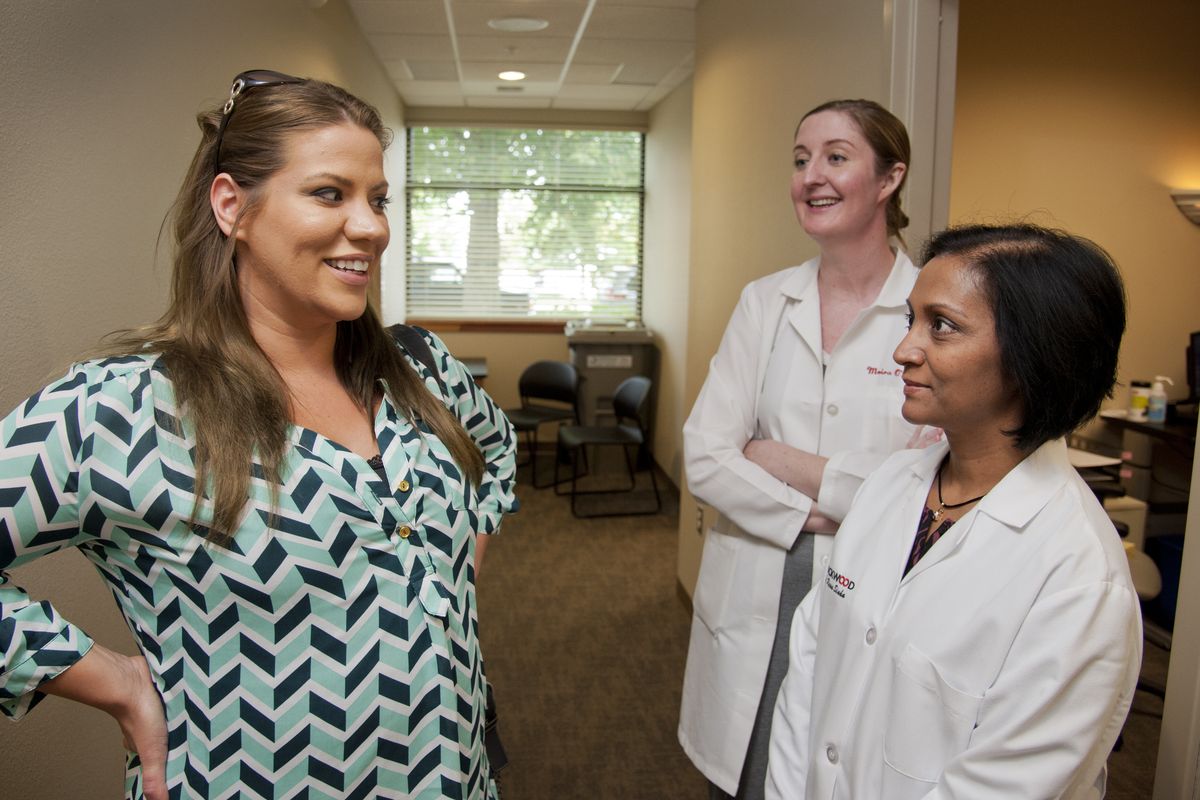Frozen treatment: Rockwood’s IceCure machine can solve benign breast tumors

“That was a scary one,” she said.
Gawenit immediately called her mother, then made a doctor’s appointment. An ultrasound revealed a tumor and she was advised to have it surgically removed and tested for cancer.
Gawenit’s grandmother and an aunt both had breast cancer so she was nervous.
One long month after finding the lump Gawenit learned the results from her surgery and could breathe a sigh of relief. She had a fibroadenoma, a benign breast tumor not uncommon in young women.
Since then, Gawenit has had three more fibroadenomas removed, a golf-ball sized tumor when she was 25 and two additional tumors this year. Compared to the surgeries she had for the first two tumors, she said the last treatment was by far the easiest.
In January, the Breast Health Center at Rockwood Clinic purchased an IceCure machine so they could offer patients like Gawenit cryoablation, a newer, noninvasive treatment that freezes the tumor with liquid nitrogen.
Young and scared
It’s estimated that 10 percent of women will get a fibroadenoma during their lifetime. Most of them, like Gawenit, are women in their reproductive years.
“They think they’re the only one this has happened to but 10 percent of people get them,” said Dr. Moira O’Riordan, a diagnostic radiologist at Rockwood’s Breast Health center. “They’re very scared and very young … They think cancer.”
Any lump, O’Riordan stressed, should be evaluated to rule out cancer. But a big part of her job is reassuring women who come in for a diagnostic ultrasound.
“When you do the ultrasound, you can tell it’s a fibroadenoma,” she said, adding that the diagnosis is always verified by a biopsy.
For pregnant and breastfeeding women, or women older than 40, doctors usually have a watch-and-wait approach with regular ultrasounds to make sure the tumor isn’t growing or changing. Younger women may also monitor smaller tumors if they aren’t causing discomfort or emotional distress.
But many patients opt to remove the hard lumps because they can be painful and continue to grow.
O’Riordan said removal is also a precaution because in very rare cases a fibroadenoma can turn into a phyllodes tumor – malignant, noninvasive tumor.
Freezing out surgery
When Gawenit found her first two tumors, surgical excision was the standard treatment. It still is in many places.
The Food and Drug Administration approved cryoablation to treat fibroadenomas in 2002, though it’s been used for many years to treat liver and prostate tumors, said Rockwood surgeon Dr. Renu Sinha, noting it isn’t recommended for malignant tumors but is a cost-effective, noninvasive option to surgery for benign breast tumors.
First, the area is numbed with lidocaine. Guided by ultrasound, the radiologist injects saline solution into the tissue surrounding the mass, creating a buffer.
Then the radiologist inserts a probe into the tumor and infuses it with liquid nitrogen. On the ultrasound screen the colder-than-ice fluid looks like a dark ball that grows as it freezes. The procedure is complete when the ice ball eclipses the tumor, which is easy to see because these types of tumors have clear margins.
“It’s super cool and very fun,” O’Riordan said. “You can see that you got it all.”
From start to finish the procedure takes a few minutes.
Compared to surgery, said Gawenit, the procedure and recovery was a breeze.
She’d learned about cryoablation from Sinha while they were monitoring two tumors found during Gawenit’s last pregnancy.
“People who have fibroadenomas will tend to have them,” Sinha said, adding that they’re also common during pregnancy thanks to an influx of hormones. Sometimes the tumors go away after birth but Gawenit’s didn’t. They were uncomfortable and after weaning her baby she wanted them out.
“I was always worried. What if there was a change?” said Gawenit, noting she wanted cryoablation instead of surgery but it wasn’t available in Spokane.
She was making plans to have the procedure in Western Washington when Sinha called her with good news.
“It’s not available everywhere but we convinced Rockwood to support this,” Sinha said. “This is a great thing for patients.”
Gawenit was one of their first.
“It was a cold sensation in one spot, like an ice pack,” Gawenit said. “It was easier than a biopsy.”
The recovery, she said, was also easier. She was swollen for about a day as her body reabsorbed the saline solution but she didn’t miss the pain, stitches, scarring and longer recovery she experienced when her other tumors were surgically removed.
“When I had surgery, it was three days before I could lift anything. It was a week before I could lift my kids. My husband had to take a week off of work to help,” she said, adding that she continued to have residual pain at the surgical site from scar tissue.
“This time, there was no pain, no scar. I didn’t think about it.”
Her doctors will continue to monitor the area with ultrasound as the tumor softens, dies and disappears.
“In about a year, it’s gone,” said Sinha.